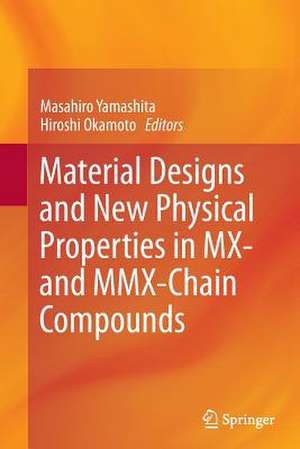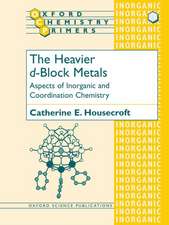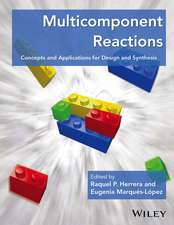Material Designs and New Physical Properties in MX- and MMX-Chain Compounds
Editat de Masahiro Yamashita, Hiroshi Okamotoen Limba Engleză Paperback – 29 ian 2015
| Toate formatele și edițiile | Preț | Express |
|---|---|---|
| Paperback (1) | 639.73 lei 6-8 săpt. | |
| SPRINGER VIENNA – 29 ian 2015 | 639.73 lei 6-8 săpt. | |
| Hardback (1) | 649.87 lei 6-8 săpt. | |
| SPRINGER VIENNA – 14 dec 2012 | 649.87 lei 6-8 săpt. |
Preț: 639.73 lei
Preț vechi: 752.63 lei
-15% Nou
Puncte Express: 960
Preț estimativ în valută:
122.41€ • 128.13$ • 101.89£
122.41€ • 128.13$ • 101.89£
Carte tipărită la comandă
Livrare economică 31 martie-14 aprilie
Preluare comenzi: 021 569.72.76
Specificații
ISBN-13: 9783709117354
ISBN-10: 3709117356
Pagini: 270
Ilustrații: X, 270 p.
Dimensiuni: 155 x 235 x 15 mm
Greutate: 0.4 kg
Ediția:2013
Editura: SPRINGER VIENNA
Colecția Springer
Locul publicării:Vienna, Austria
ISBN-10: 3709117356
Pagini: 270
Ilustrații: X, 270 p.
Dimensiuni: 155 x 235 x 15 mm
Greutate: 0.4 kg
Ediția:2013
Editura: SPRINGER VIENNA
Colecția Springer
Locul publicării:Vienna, Austria
Public țintă
ResearchCuprins
1 General Intoruduction S. Takaishi and M. Yamashita.- 2 MX-Chain Compounds.- 2.1 Pt(II)-Pt(IV) and Pd(II)-Pd(IV) Mixed-Valence Compounds H. Matsuzaki and H. Okamoto.- 2.2 Ni(III) Mott-Hubbard Compounds S. Takaishi and M. Yamashita.- 2.3 Pd(III) Mott-Hubbard Compounds S. Takaishi and M. Yamashita.- 2.4 Photoinduced Phase Transitions in MX-Chain Compounds H. Matsuzaki and H. Okamoto.- 2.5 Nonlinear Electrical Conductivity, Current Oscillation and Its Control in Halogen-Bridged Nickel(III) Compounds H. Kishida and A. Nakamura.- 2.6 Gigantic Third-Order Optical Nonlinearity of Halogen-Bridged Nickel(III) Compounds H. Kishida and H. Okamoto.- 2.7 Theory of MX-Chain Compounds K. Iwano.- 3 MMX-Chain Compounds.- 3.1 Crystal Structures and Properties of MMX-Chain Compounds Based on Dithiocarboxylato-Bridged Dinuclear Complexes M. Mitsumi.- 3.2 POP-Type MMX-Chain Compounds with Binary Counter-Cations and Vapochromism H. Iguchi, S. Takaishi and M. Yamashita.- 3.3 Photoinduced Phase Transitions in MMX-Chain Compounds H. Matsuzaki and H. Okamoto.- 3.4 Theory of MMX-Chain Compounds K. Yonemitsu.
Textul de pe ultima copertă
This is the first book to comprehensively address the recent developments in both the experimental and theoretical aspects of quasi-one-dimensional halogen-bridged mono- (MX) and binuclear metal (MMX) chain complexes of Pt, Pd and Ni. These complexes have one-dimensional electronic structures, which cause the various physical properties as well as electronic structures. In most MX-chain complexes, the Pt and Pd units are in M(II)-M(IV) mixed valence or charge density wave (CDW) states due to electron-phonon interactions, and Ni compounds are in Ni(III) averaged valence or Mott-Hubbard states due to the on-site Coulomb repulsion. More recently, Pd(III) Mott-Hubbard (MH) states have been realized in the ground state by using the chemical pressure. Pt and Pd chain complexes undergo photo-induced phase transitions from CDW to MH or metal states, and Ni chain complexes undergo photo-induced phase transitions from MH to metal states. Ni chain complexes with strong electron correlations show tremendous third-order optical nonlinearity and nonlinear electrical conductivities. They can be explained theoretically by using the extended Peierls-Hubbard model. For MMX-chain complexes, averaged valence, CDW, charge polarization, and alternating charge polarization states have been realized by using chemical modification and external stimuli, such as temperature, photo-irradiation, pressure, and water vapor. All of the electronic structures and phase transitions can be explained theoretically.
Caracteristici
Low-dimensional semiconductors with exciting optical properties are extensively discussed Physical properties arising from quasi-one-dimensional electronic systems are covered Various photoinduced phase transitions and their dynamics are presented Includes supplementary material: sn.pub/extras








